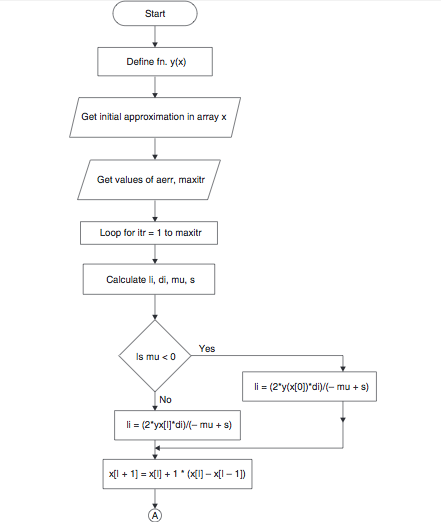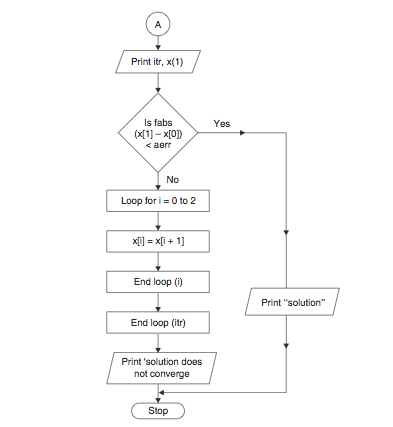Muller’s Method Algorithm and Flowchart
Muller’s method is generalized a form of the secant method. This method was developed in 1956 by David Muller. It is generally used to locate complex roots of an equation. Unlike the Newton Raphson method, it doesn’t required the derivation of the function.
The convergence in Muller’s method is linear, faster than the secant method, but slower than the Newton Raphson method. The algorithm and flowchart for Muller’s method presented here require initial approximations in an array.
The algorithm or flowchart can be referred to write program for Muller’s method in any high level programming language. The approximation here is done by a parabola of second degree intersecting these points.
The effort in Muller’s method or its algorithm may be a bit tedious, but this can be made a bit simpler by taking only three initial guesses. The approach used here is quadratic interpolation of these guesses. However, the use of array can facilitate in more understandable and readable expressions.
Muller’s Method Algorithm:
- Start
- Declare function f(x)
- Get initial approximation in array x
- Get values of aerr and maxitr
*Here aerr is the absolute error
Maxitr is the maximum number of iterations for the desired degree of accuracy* - Loop for itr = 1 to maxitr
- Calculate li, di, mu and s
- If mu < 0,
I = (2*y(x[0]*di)/(-mu + s) - Else,
I = (2*y(x[I]*di)/(-mu – s) - x[I + 1] = x[I] + l*(x[I] – x[I – 1])
- Print itr and x[l]
- If fabs (x[l] – x[0]) < aerr,
Print the required root as x[l] - Else,
Loop for i=0 to 2
x[i] = x[i + l] - End loop (i)
- End loop (itr)
- Print the solution does not converge
- Stop
Muller’s Method Flowchart:

 Also see,
Also see,
Muller’s Method C Program
Apart from the algorithm and flowchart presented here, Muller’s method itself is not considered much effective for locating the real roots of a function. As, the method converges quadratically for the initial approximations, it is more useful when it comes to locating the complex roots of a function. So, Muller’s method can effectively produce complex roots, even though the initial guesses are real.
The Muller’s Method Algorithm and Flowchart is a simple yet powerful process to solve any problem. This process is widely used by engineers and programmers across the world. This process can be applied in almost every field to make it more efficient and productive. This method can be used to solve any kind of problems in software engineering and can be applied in the areas of programming, math, science, and many more.
This Muller’s Method Algorithm and Flowchart consists of two steps. First, we have to identify the problem and then solve it.
Step 1: Identify the Problem
Problem Solving is the first step in solving any kind of problems in software engineering. We have to first identify the problem and then come up with the solution. If we know the problem, then we can easily come up with the solution.
In software engineering, the problem is normally divided into two categories:
1. Static Problems: These problems are those in which there is no flow of information. In this case, there is no change in the state of the program. For example, we can say that there is no change in the state of the program if the output of the program is always the same and the input is always the same.
2. Dynamic Problems: These are those problems in which there is a change in the state of the program. For example, if the input changes and there is a change in the state of the program, then this is a dynamic problem.
Here are some examples of static problems.
- The output of the program is always the same.
- There is no change in the state of the program.
- There is no interaction between the input and the output.
- There is no input to the program.
- The output of the program is always the same.
- There is no output from the program.
- The input of the program is always the same.
- Here are some examples of dynamic problems.
- The input of the program changes.
- The output of the program changes.
- There is an interaction between the input and the output.
- There is an input to the program.
- There is an output from the program.
- The output of the program changes.
Step 2: Find the Solution
After identifying the problem, we need to find the solution to the problem. This solution can be either a new algorithm or a new piece of code. Once we come up with the solution, we have to implement the solution.
Step 3: Implement the Solution
After implementing the solution, we should test the solution. The testing of the solution is necessary to check whether the solution works fine or not. In order to find the solution, we can use the Muller’s Method Algorithm and Flowchart.
Step 4: Evaluate the Solution
Once we have implemented the solution and tested the solution, we should evaluate the solution. Once we have evaluated the solution, we have to make a decision on whether to implement the solution or not.
Step 5: Decide Whether to Implement the Solution
After evaluating the solution, we should decide whether to implement the solution or not. If we do not implement the solution, then there will be no improvement in the performance of the program.
Step 6: Implement the Solution
After deciding to implement the solution, we should implement the solution. We have to implement the solution and run the program to see the result. After running the program, we should again decide whether to implement the solution or not.
Step 7: Repeat Steps 4 to 6
We have to repeat the steps until the performance of the program is improved. We can also find the problem once again. Once the problem is identified, we can use the Muller’s Method Algorithm and Flowchart to find the solution.






